The EcoFlow Wave is the company’s new highly versatile, multipurpose 4,000 BTU portable air conditioner that focuses on finding a balance between cooling performance, portability, and battery life. Highlighted by its unique power and cooling options and mobile app control, one of the biggest draws of the Wave AC is its battery-powered functionality.
This opens up a lot of flexibility, application-wise, as it is quoted to last anywhere between three to twelve hours (depending on which battery is being used). Users can extend its usage by customizing the fan and cooling setting to best suit their needs, with the ability to easily remove the extra battery whenever portability is more important than longevity.
EcoFlow Wave Portable AC Applications
It’s the perfect season for a new portable AC, as the hot days of summer are now here, in North America anyway. While many people will see the EcoFlow Wave as a means to keep areas like their tents or RVs cool during the camping season, it will also suit a variety of IT needs. Specifically, the Wave will be very useful for IT and field deployments when they need to get systems operational or serviced when equipment fails.
The summer weather doesn’t just affect the outdoors, it also makes it difficult to keep regulate thermal control in areas like server rooms when executing heavy work-load tests. Its battery-powered option also allows us to easily place the AC unit in areas where power outlets might not be available. We can also attach tubing for directed, efficient cooling.
For example, its dual hose build allows us to set up the Wave to draw hot air and vent it outside via a window, making this a very efficient portable AC. With two different shrouds, the EcoFlow Wave can be used in different situations, optimized for the use case.
First, the EcoFlow Wave is a two-hose design. When you look at an air conditioner there are two fans that move air, one for the hot side and one for the cold side. You need a hot-side or condenser intake and exhaust as well as a cold-side or evaporator intake and exhaust.
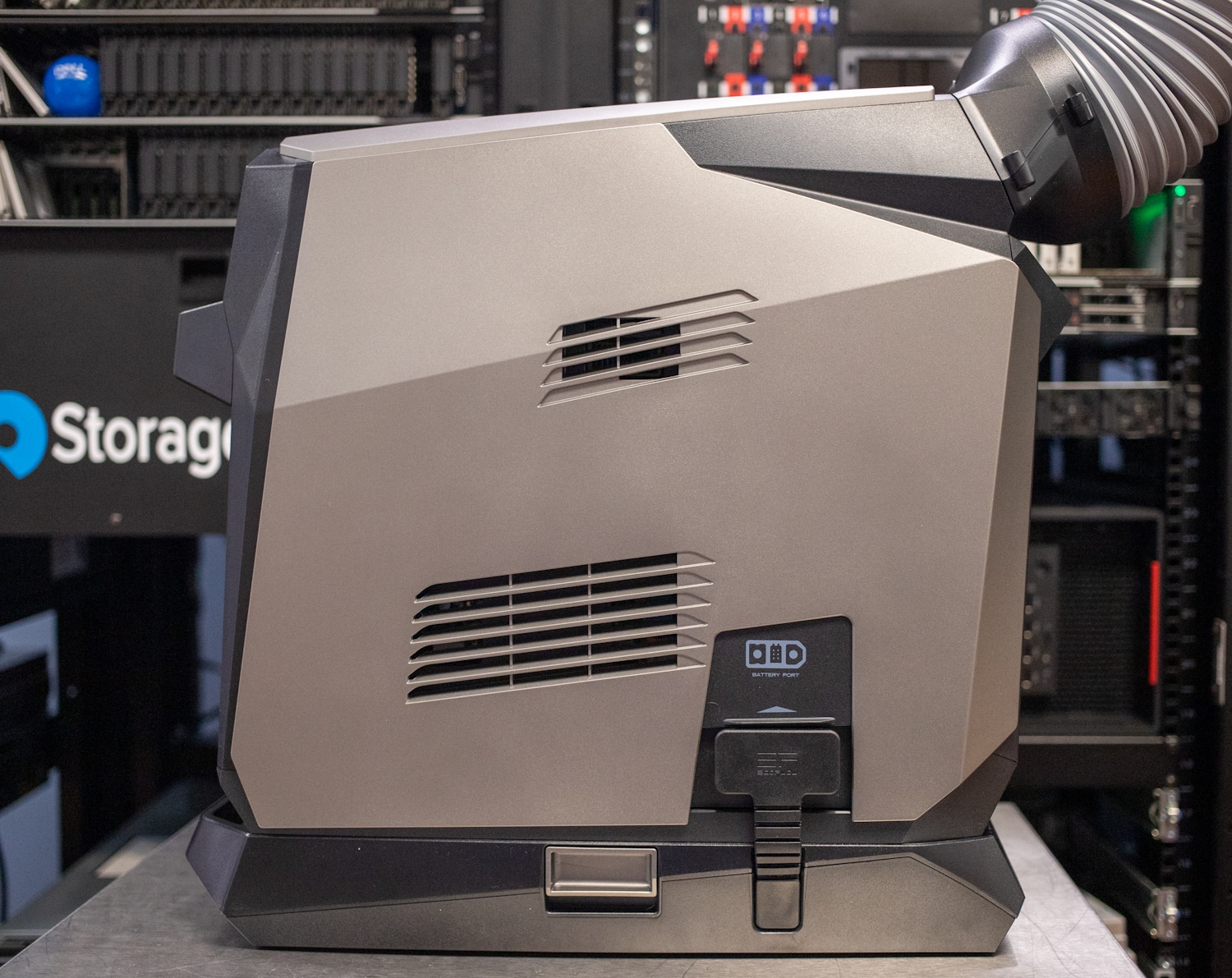
Two hose models allow you to move the hot-side intake and exhaust outside your conditioned area, whereas a single hose design only pushes the hot air away. The downside to a single hose configuration is that you end up drawing your conditioned air away, reducing the efficiency of your system and forcing outside air into your conditioned envelope. With that out of the way, we will get into where the shrouds can be leveraged.
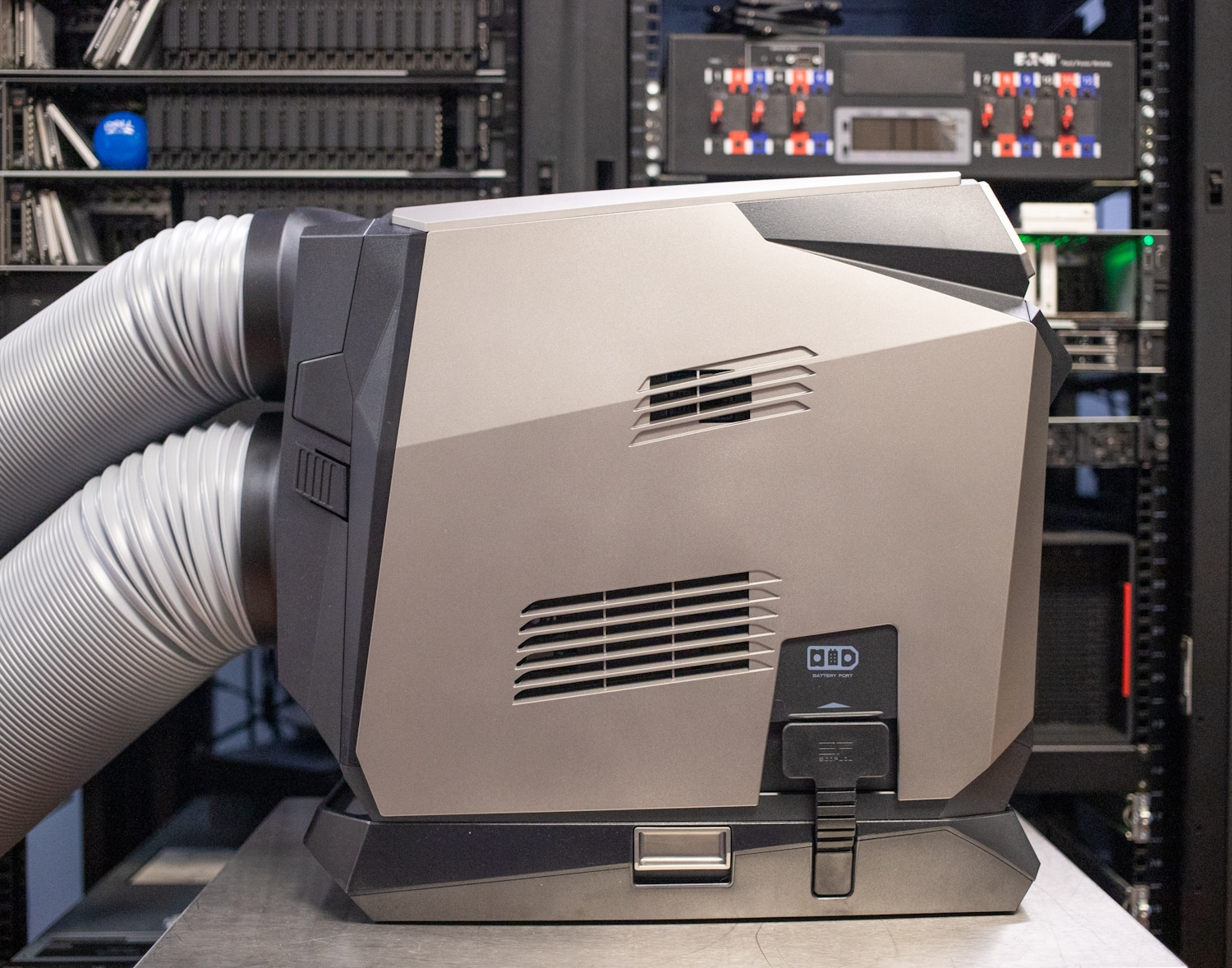
The primary shroud is for the back of the unit, converting the system into a dual-hose AC unit. You have one hot for the hot-side intake and another for the exhaust, and you position each of these outside the area you are trying to cool down. The second shroud is for when you have the entire AC unit outside your conditioned space, and you are looking to blow directed cold air into an area or at something.
For remote fieldwork using the two-hose method connected to a window, opening would be the most efficient use case. If you are working in a situation where a primary AC unit failed and are trying to get specific equipment back into its operating temperature ranges, using the front shroud to direct cold air at specific items can also be very helpful. The EcoFlow Wave definitely has a lot of configuration options to help with a wide range of use cases.
EcoFlow Wave Portable AC Add-on Battery and Power Efficiency
While the EcoFlow Wave can operate just fine on normal household 120V power, there are other options to run it in the field. Power-wise, you can get around three hours of straight cooling with the add-on battery (more if you change some settings around) and up to 12 hours with the Wave’s DELTA Pro portable home battery. These are times with the AC running constantly, but if you are able to balance the output you can get much longer runtimes with the compressor being able to cycle on and off.
Nonetheless, EcoFlow makes it easy to install the addon battery. Simply put the Wave unit on top of the battery pack and slide it in until you hear a clicking noise. Next, we just had to connect the battery plug on the side into the port on the air conditioner and we were good to go.
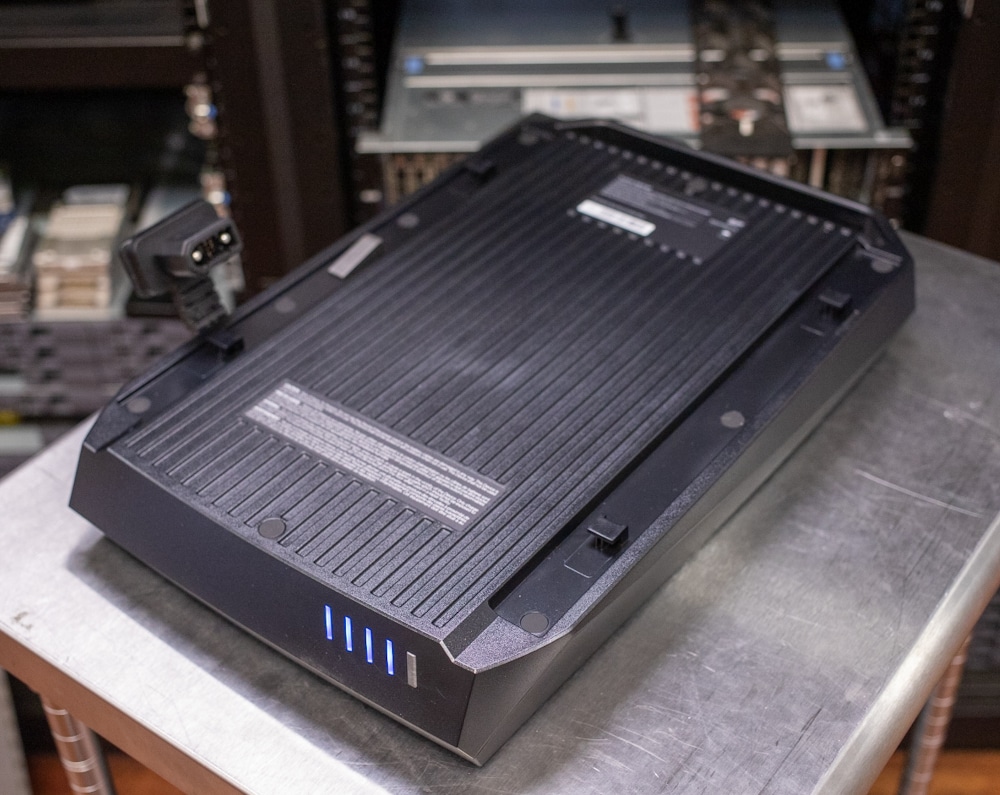
The Wave supports many portable power stations with a high enough of rated output. You also don’t have to use one of their proprietary products, as any portable power station with a 700W output can charge or operate the Wave. For remote field use, the add-on battery can be charged through the Wave (up to 200W) via solar panels, which takes roughly five hours.
Here is a quick rundown of how long the Wave will last using specific EcoFlow-branded portable power stations:
| Battery | Max Running Time* (Hour) |
| Wave Battery Pack | 3 |
| DELTA Pro | 12 |
| DELTA Max (2000) | 6 |
| DELTA Max (1600) | 5 |
| DELTA (1300) | 3 |
| DELTA (1000) | 2.5 |
| DELTA mini | 2 |
| RIVER Pro | 1.7 |
You can also plug it into any standard wall outlet to get a full charge with the add-on battery in 2 hours. You can even plug the Wave into a car outlet to get a 200W charge in roughly 5 hours.
EcoFlow Wave Portable AC Moisture Prevention
The Wave is designed to redirect any water that materializes (an issue inherent in all air conditioners) to its heating tube, which means the water will evaporate due to the heat. This will keep your area nice and dry during and after cooling, though EchoWave indicates that humidity should be below 70% to guarantee zero-moisture build-up.
Backed by a 1-year warranty, the EcoFlow currently goes for $1,200 (without the add-on battery) on the official website.
EcoFlow Wave Portable AC Specifications
| Net weight | 38.58 lbs |
| Dimensions | 20.39 x 12.2 x 16.38 in |
| Wi-Fi | Supported |
| Bluetooth | Supported |
| AC input voltage/frequency | 115V 60Hz |
| Add-On Battery power | Max 600W |
| AC input power | Max 700W |
| Solar charging input | 11-35V Max 12A Max 200W |
| Car charging input | 12 V/24V Max 8A Max 200W |
| Ambient temperature | 5°C ~ 50°C (41°F ~ 122°F) |
| Cooling temperature settings | 16°C ~ 30°C (60.8°F ~ 86°F) |
| Cooling capacity | 1200W |
| Circulation air volume | 290m³/h |
| Refrigerant/amount | R134a/14.1oz |
| Rated cooling power (AC/DC) | 460W/410W |
| Max. cooling power | 600W |
| Noise | <55dB |
| No-Drain Function | Supported |
| Shut Down When Full Function | Supported |
| Warranty | 12 months |
EcoFlow Wave Portable AC Design and Build
Overall, we found the build quality of the EcoFlow Wave very nice. Its front and rear have built-in handles that can be used to move it around easily, while the power cable connects through the side and can be removed without hassle. This makes for tangle-free cable management when moving it from one location to another. Included shrouds snap into place on the front or rear to attach corrugated tubes, which detach pretty quickly for stowing.
As far as its build goes, it measures just over 20 tall, roughly16 inches in depth, and weighs in at around 30lbs. This makes the portable AC unit a fairly compact and portable device as a stand-alone unit. However, once the add-on battery is installed (which weighs about 20lbs) it gets fairly hefty, so you will have to be a bit careful with lugging it around.
It can potentially output the same cooling performance as larger and more traditional wall/window air conditioners for room sizes under 50 square feet. EcoFlow indicates that it takes roughly 8 minutes to cool down the ambient temperature from a very warm 86°F to a moderate 75°F. This is pretty impressive for its size.
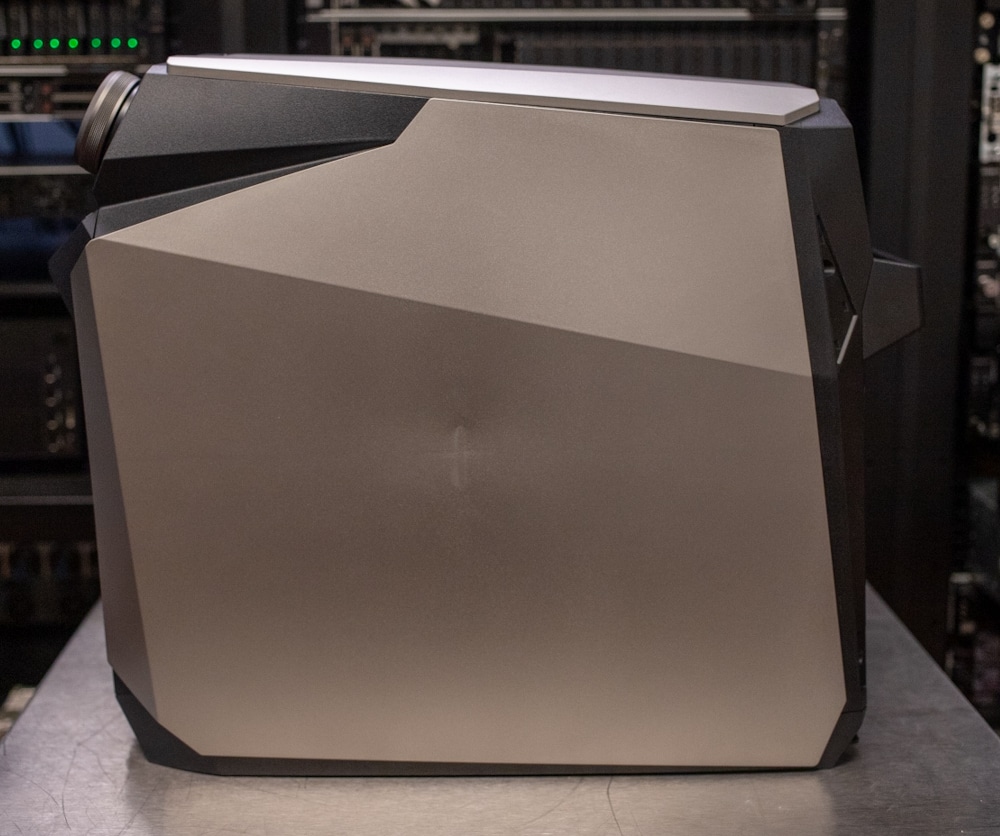
The top of the front panel is home to all the functionality, including the mode, temperature, timer, and power buttons. Below the row of buttons is the versatile LCD dial/screen and the cold-end air outlet, with most of the front real estate is taken up by the cold-end air inlet.
On the left side are the inverter outlet and inlet vents, as well as the solar/car charging input port, AC input port, and addon battery port. The inverter in this case is what converts incoming AC power to DC power the AC unit uses natively. When the unit is running, you can hear and feel the smaller fan running.
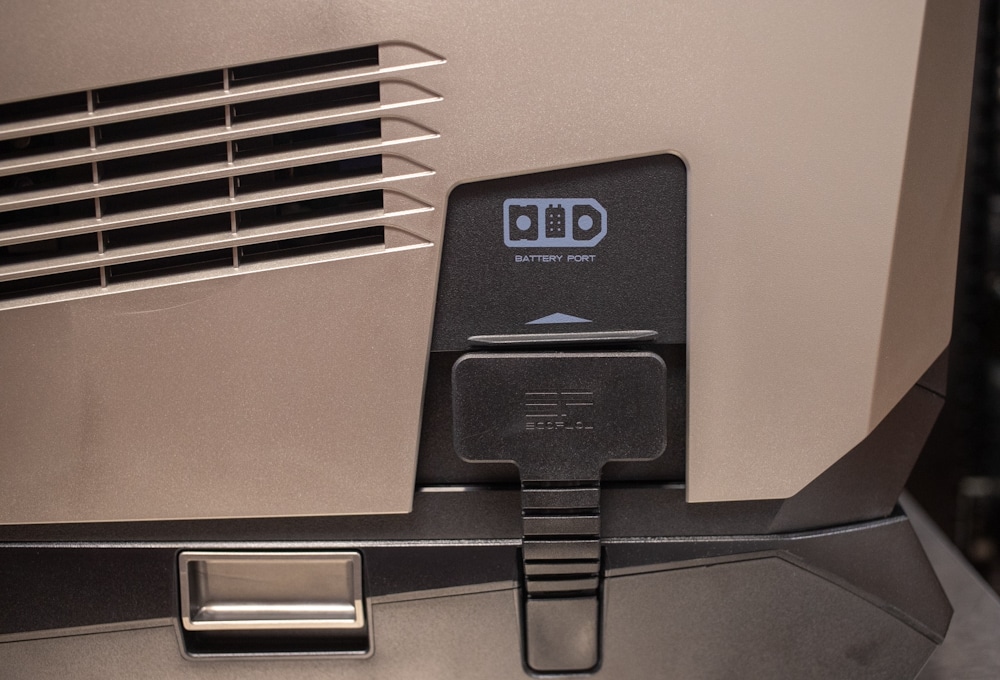
As you can see below, these power ports are easily accessed by sliding up the protective cover shown below.
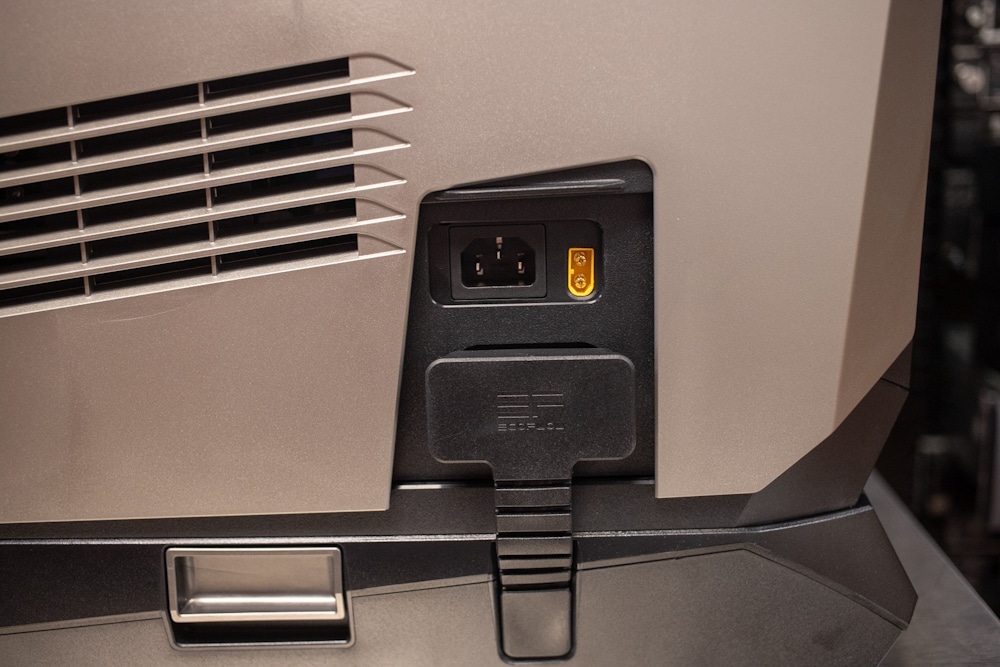
The rear side of the Wave portable AC unit is home to the hot-end air outlet, hot-end air inlet, and drainage outlet (at the very bottom). It also has a very sturdy handle built-in.
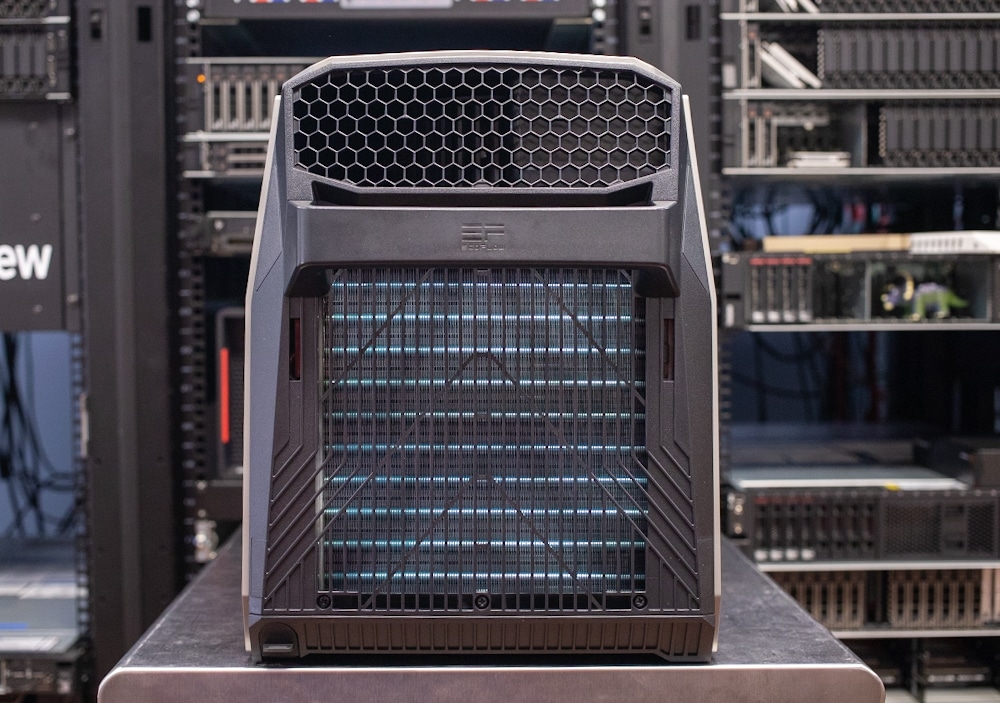
Internal Design
Under the hood, you will see that the layout is pretty neat. It has an inverter compressor, two cage fans for hot and cool sides, a condensate pump so water can be evaporated out the hot exhaust, and an AC to DC charging controller to handle incoming power from multiple sources.
The EcoFlow Wave is rated for a cooling load of 4,000 BTU with a compact R134a-based compressor. While the system isn’t designed to be user-serviced, it wasn’t too difficult to gain access to the inside. EcoFlow uses a mix of screws and plastic clips to hold panels together, keeping everything snug in our use.
In the photo below, left to right you see the evaporator, and cold-side fan which is insulated to minimize heat intrusion from the warmer components around it. This fan is rated for moving 170 CFM at full speed. Towards the middle, the gloss-black cylinder is the inverter-based compressor and to the far right is the condenser.
The condenser fan is located above the compressor, which draws air in from through the condenser and out the top vent. This design also helps partially cool the compressor itself during operation. Slightly visible are vibration dampers on which the compressor is mounted, helping minimize noise and vibration operation.
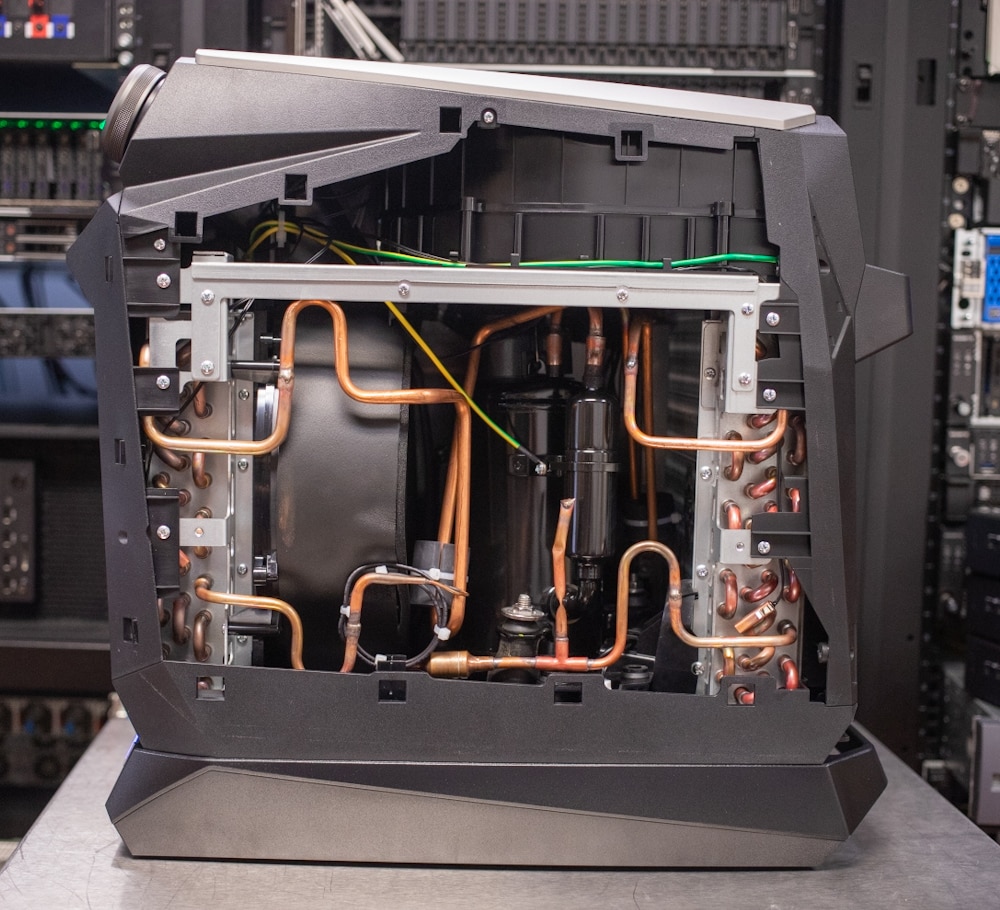
On the other side of the unit, you see the electrical components. Here is where AC-power, solar/car DC input, as well as battery pack inputs, are located. Under the middle covered area is the power circuitry for the system. It has two small air intakes to draw fresh air in and cool the components and a little blower wheel seen towards the top that expels that warm air. The engineering that went into the EcoFlow Wave is pretty impressive, keeping everything snug and shielded for rugged conditions.
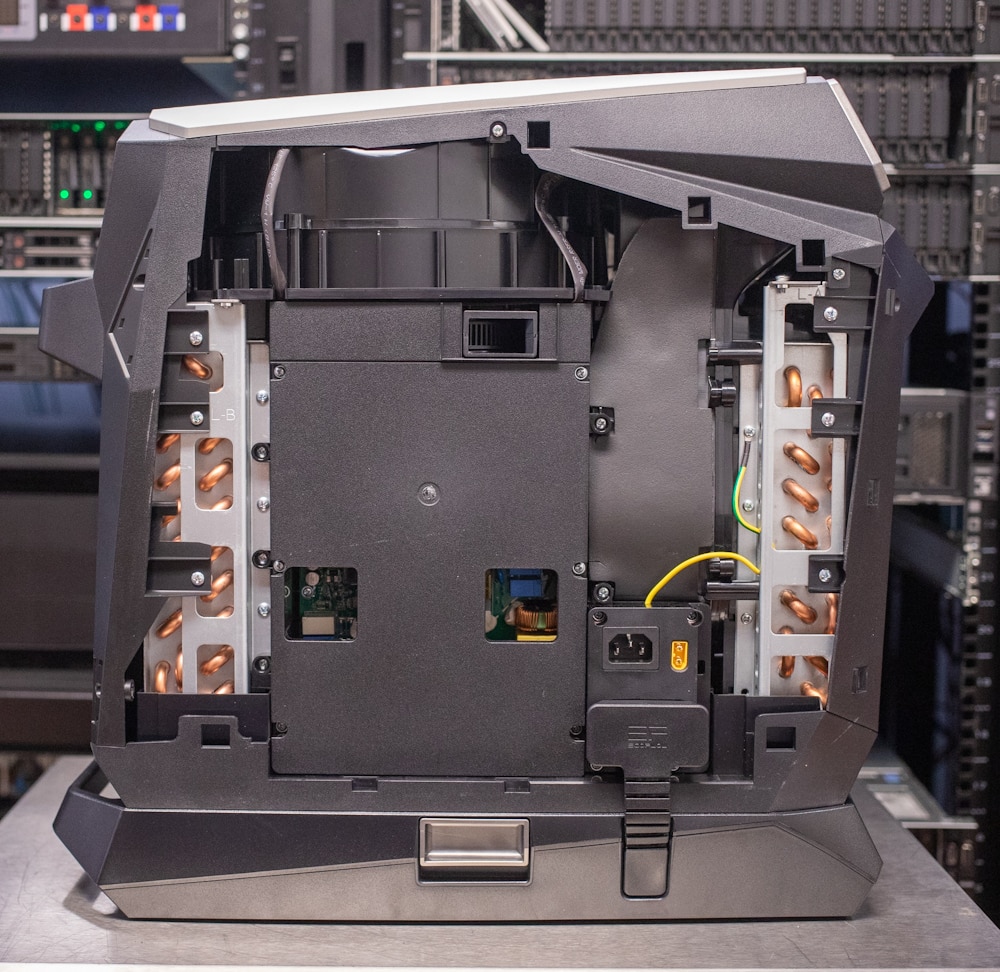
EcoFlow Wave Usability
Ease of use is another focus of the EcoFlow Wave, as we found setting up the portable AC extremely simple with minimal maintenance involved afterward. For example, we added the cold-end fan shroud (which easily snapped into place) and then attached the duct by turning it clockwise until it locked into place. This configuration helps to direct cold air to specific items.
The hot-end fan shroud and duct were also easy to install, the former of which quickly snapped into place while the latter was easily secured by turning clockwise. Using this type of configuration would be to cool a small area, dumping the hot air outside the space. To enable drainage, you simply pull the plug/cap upward (located at the bottom left of the portable AC) and then attach the drainage tube.
Once we turned on the EcoFlow Wave (by short-pressing the power button), the LCD screen lit up right away and the power indicator started pulsing. To turn it off, simply long-press the power button again.
The LCD screen is simple and to the point–something users will certainly appreciate. You see the fan or cooling mode, fan speed increments, and temperature setting quickly. When you have a battery connected, the screen has information showing estimated runtime on discharge and then estimated charge time when charging.
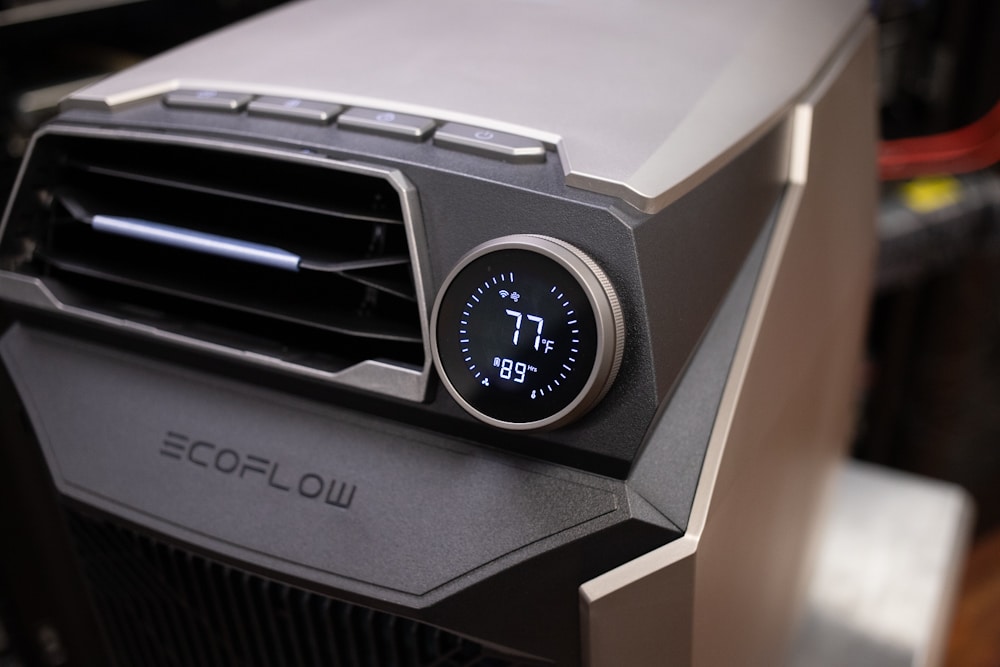
More specifically, the temperature display is front and center along with the temperature unit and setting status. Along the top middle are the WiFi connection status, fan mode, cooling mode, and Bluetooth connection status icons. The bottom displays the battery level, air volume setting, timer status, and timer/charging time display. The screen will automatically switch off after being idle for 5 minutes or after you short press the power button again.
To lower and raise the set temperature of Wave’s air conditioning, simply turn the dial clockwise and counterclockwise, respectively. Those living in Canada or other countries that use the metric system can easily change between Fahrenheit and Celsius by holding the “Temperature” button for three seconds. You can also easily switch from cooling mode to fan mode (i.e., non-cooled air) by short pressing the “Mode” button.
EcoFlow Mobile App
The EcoFlow Wave can be remotely managed by a free mobile app available on both the Android Play and iOS App stores. This is the same program leveraged for other EcoFlow products such as portable power stations, keeping everything managed in one spot. Overall, we found the app to have a responsive UI and a premium look and feel with some pretty slick animations. It’s also very straightforward and doesn’t overwhelm the user with too many options; it just has the necessary settings any user would want to access remotely.
For example, you can set the timer (i.e., how long you want it to operate before it automatically turns off) and find detailed information on the state of the battery, including the remaining charge and the current input and output power.
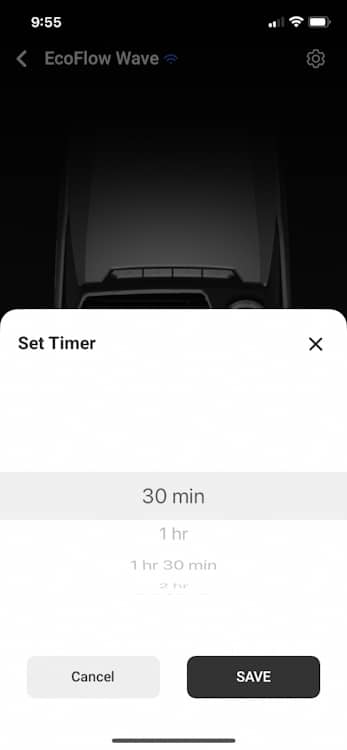
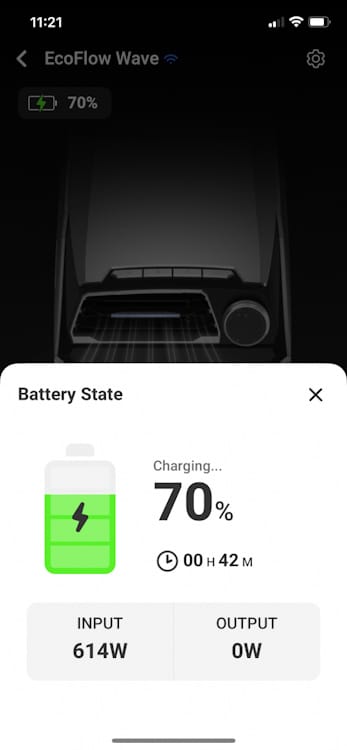
You can also easily set a fixed temperature in “Cool” mode or set it to “Eco” (which has three different levels) to improve power efficiency.
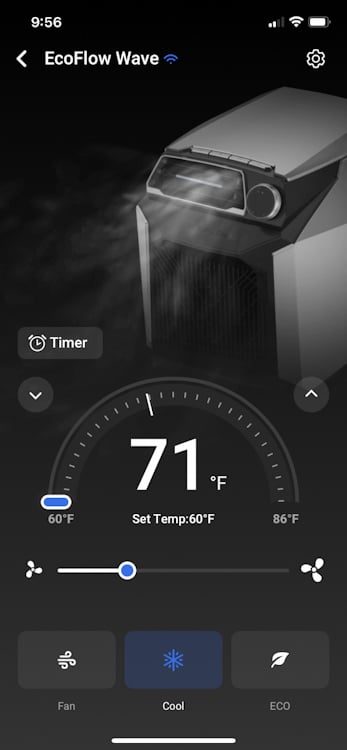
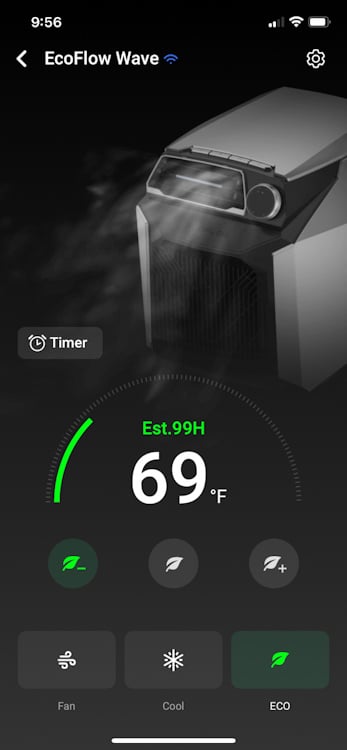
When you set it to “Fan” mode, you can easily control the fan speed via a simple slider. In addition, you can customize a range of settings, including adding beep notifications, enabling automatic drain, setting the automatic screen timeout on the LCD dial display, and updating the firmware.
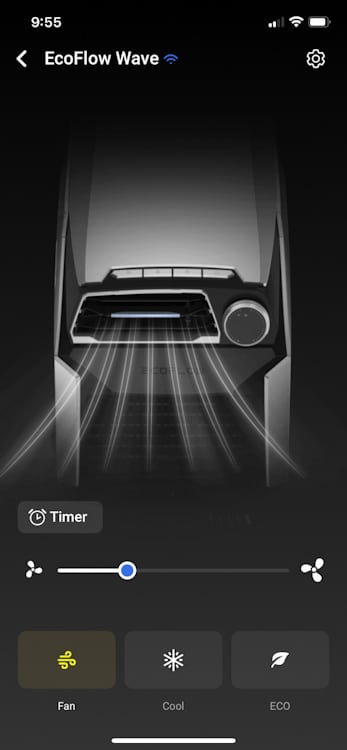
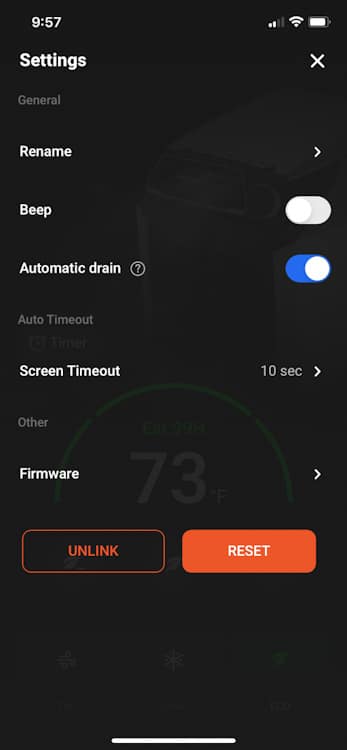
Power Consumption
When the idea of a battery-powered portable AC unit comes up, the first question that pops into your head is going to be “How long will it run?”. The next is probably “How big of a battery does that thing have?”. The EcoFlow Wave is very unique when it comes to both of those answers. At first glance, the Wave is designed to fully operate through external AC power or a connected battery pack. AC power is the most straightforward as it connects over a normal three-prong outlet, with a GFCI module built into the end.
The battery methods get a little more complex. Primary is a clip-on 1008Wh battery designed for the EcoFlow Wave that interfaces over a DC-power port. Additionally, you can use the DELTA Max or DELTA Max Extra Battery through a DC-power cable, as well as the DELTA Pro or DELTA Pro Extra Battery through a DC-power cable as well.
The DC interface allows you to bypass the power station’s internal inverter for a more efficient connection without added power loss. You also bypass the power station’s inverter component as well, giving you another leg up on efficiency. Another smart design choice is that the Wave can directly charge those batteries through its own AC or DC power source. DC power sources include the ability to connect Solar panels or a car power cable to get the unit topped off during daylight hours. There are a ton of options to power the EcoFlow Wave on-site.
When it comes to power consumption specifically, the EcoFlow Wave is very efficient. It uses an inverter-style refrigerant compressor to slowly ramp up to its rated load, instead of needing a huge peak load to start. Connecting the EcoFlow Wave to our lab’s power meter, we measured the activity during the process of the Wave kicking on the AC compressor to start its cooling cycle. As you can see, it has a slightly initial kick measuring 381 watts, which looks like a spike, but is under the unit’s peak power draw as it fully ramps up.
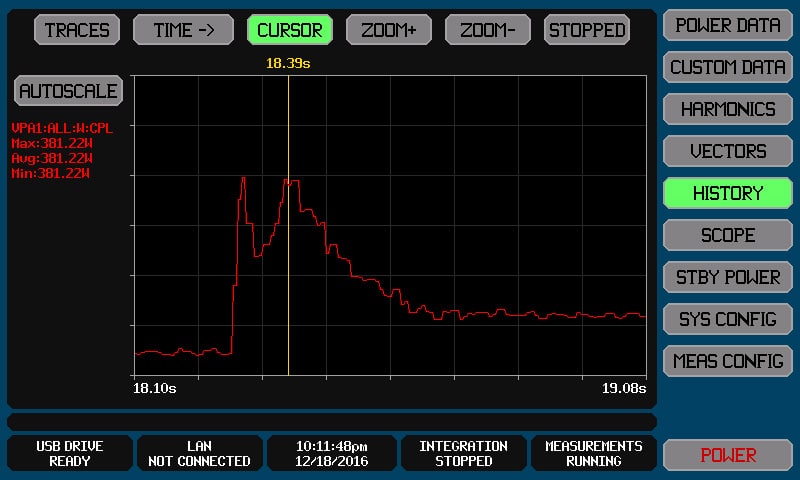
Zooming out to capture the entire ramp-up process where the EcoFlow Wave builds to peak cooling capacity, we see a final peak of 520 watts or so. At the very start, you can see a very faint line, which is the compressor kicking on. If this were a traditional AC compressor, that initial peak would be exponentially higher than the full power draw of the AC unit. In short, the EcoFlow Wave is very inverter and generator friendly with how it operates.
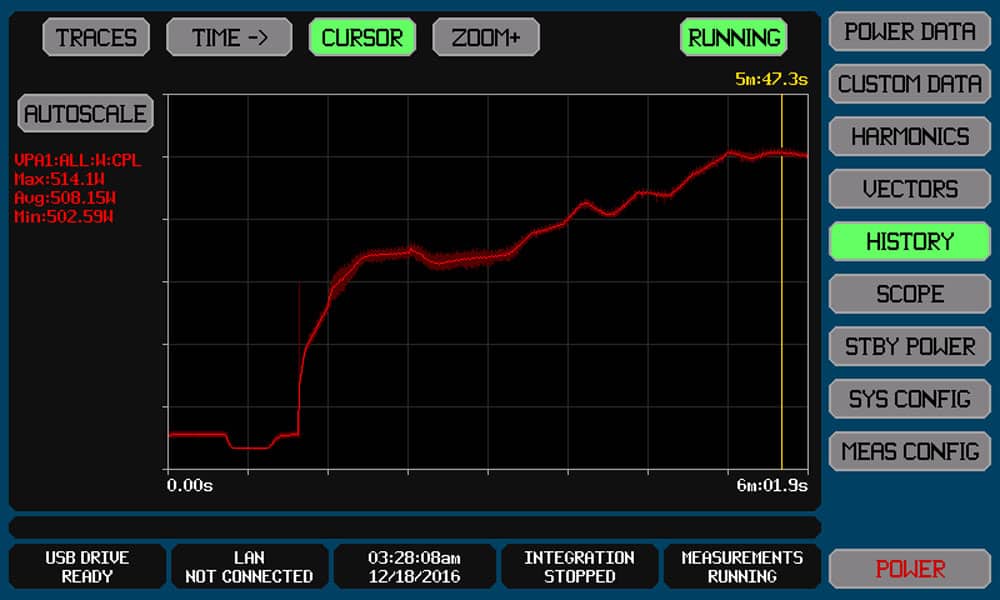
While the peak power draw has the unit operating with the fan at full speed and the AC in the “max” mode, dialing it back a bit with roughly 50% fan speed, power does taper off some. Here we see an average load of 485 watts.
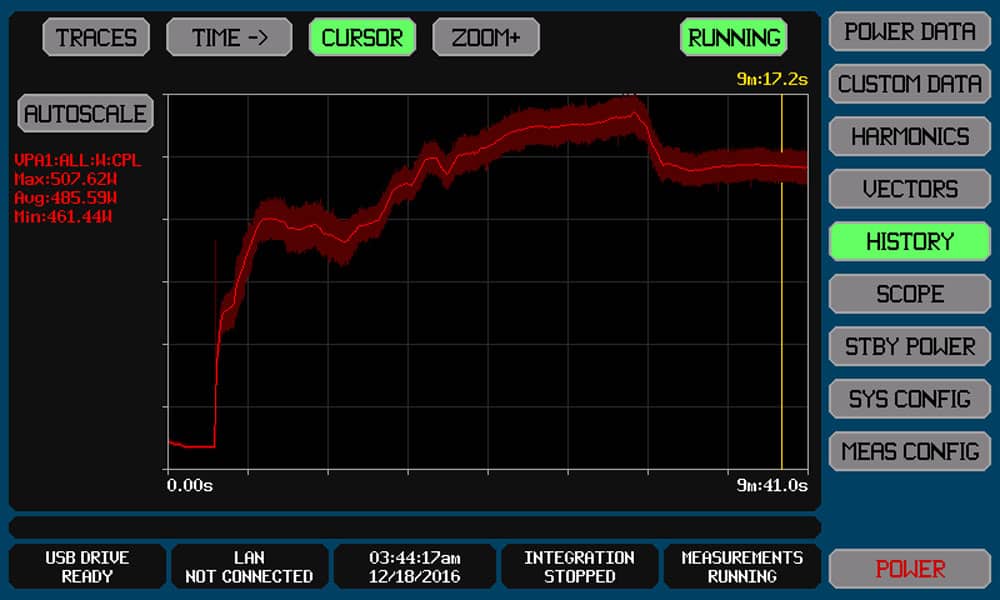
With just the fan operating in high-speed mode, we measured around 56 watts on average.
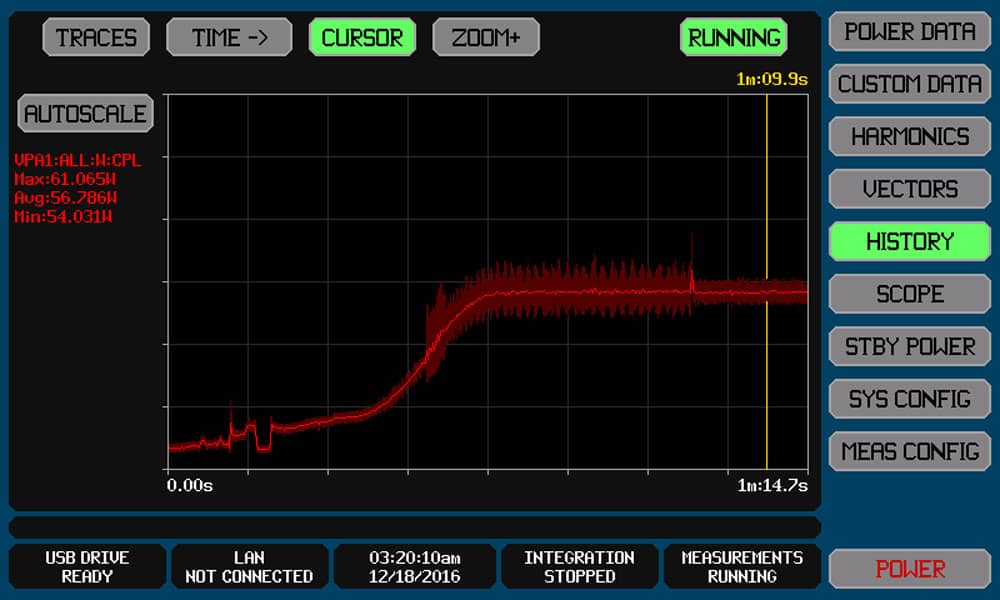
Dropping the fan to its lowest speed, it tapers down to 19 watts.
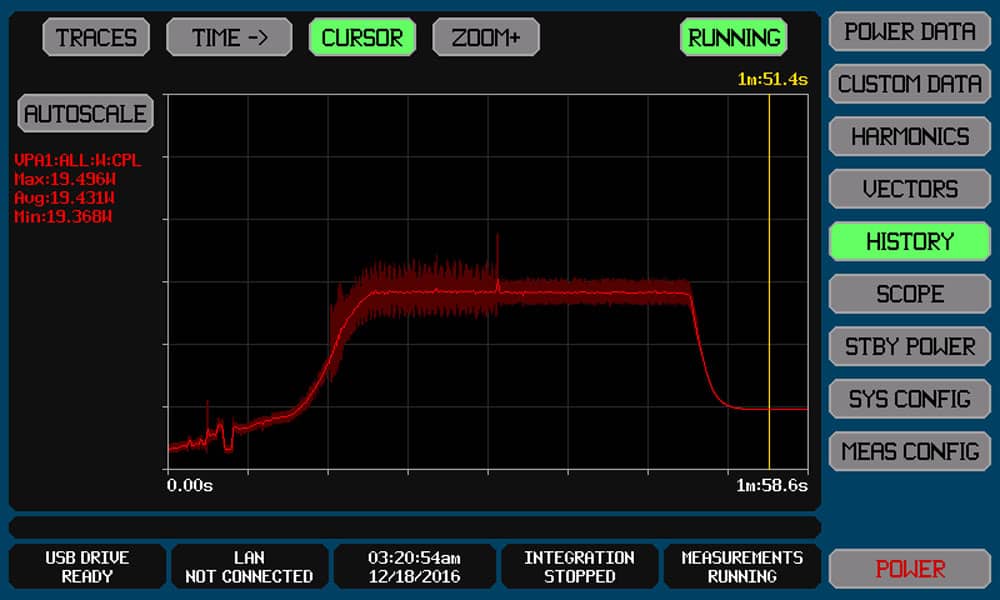
Finally, we measured the AC power requirements of the charging process. The EcoFlow Wave charges the add-on battery out of the 700-watt power envelope it’s rated to draw from an AC outlet. We kicked on the unit to start the AC portion and watched the power draw not budge in the slightest. There is no compressor surge, and no tapering of the power drawn from the AC outlet.
Watching inside the app you can view the input charge rate vary depending on the AC load. For example, if the AC unit is drawing 450 watts, the battery is charging with the 250 watts remaining. For DC-charging via car or solar, the unit supports a 200-watt charge rate.
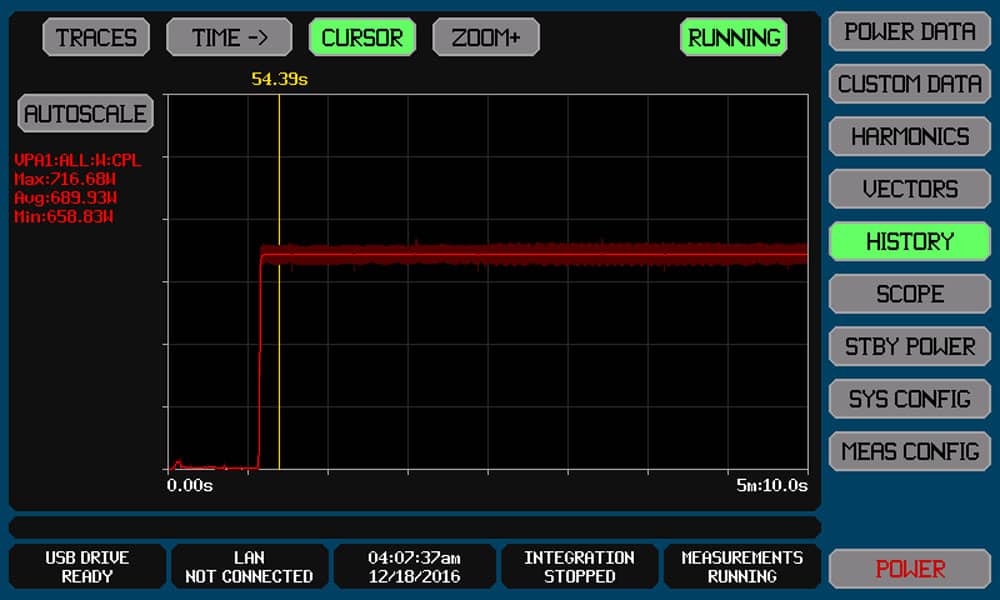
In terms of runtime, the EcoFlow Wave is going to be entirely dependent on the area or devices you are trying to cool. If the area has some amount of insulation and the Wave is able to cycle on and off, the runtime will be dramatically different than if you are running it on full with a 100% duty cycle. With the battery pack alone having a 1008Wh capacity, if you are running the unit on-site continuously, you will see under 3 hours of runtime. Now if you have control over the space without a lot of heat added back into the space, you could easily double or triple that number.
Conclusion
Overall, we really liked the EcoFlow Wave. This portable AC unit has a feature-packed compact design, is built very well, and has a lot of functionality that makes it a very flexible device for both indoor and outdoor use cases. The EcoFlow also comes bundled with two hoses and two shrouds so you can have different placement options. In its most efficient configuration, the Wave can be set up to use two hoses. This means you can draw in hot air and then exhaust it outside your AC envelope, so it will operate more efficiently compared to AC units with a single hose design.
The possibilities for the EcoFlow Wave portable AC unit are many. While the camping and off-grid use cases will be popular, we liked it the remote IT deployment use cases. Delivering cool air while systems get operational in the field or supplying emergency cooling in an IT hut when primary cooling goes down, the Wave can be an integral addition to your kit. The Wave can also offer supplemental cooling in a truck running edge devices, being very power friendly to power inverters. For the outdoor-focused sysadmin, the EcoFlow Wave is definitely worth checking out.


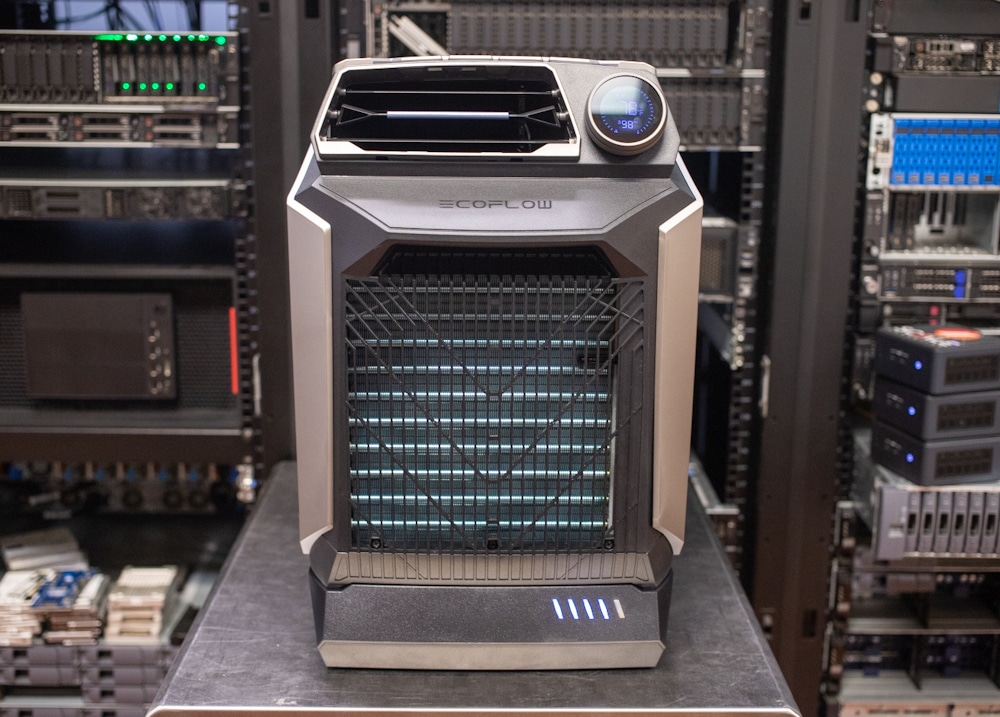


 Amazon
Amazon